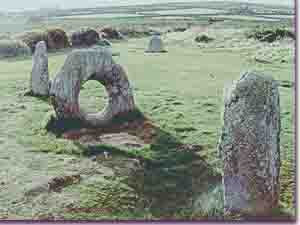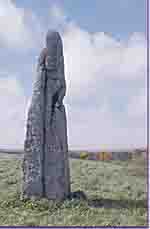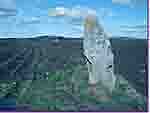|
|
There are upwards of 90 historical menhirs, or standing
stones, in West Penwith. Many of these are relatively small, and
some have been moved from their original positions by farmers over
the centuries. Some have been placed as parish boundary markers.
Others, notably The Pipers
near the Merry Maidens
are up to 15 feet tall.
Their original purpose can only be guessed at, though
some appear to be aligned with nearby stone circles, which suggests
a religious significance. Most single standing stones date back
to the Bronze Age, and many are early Christian, though they continue
to be erected to this day in local farms and gardens. The Men
Scryfa stone near the Men-an-tol is
a Romano-British memorial, and is inscribed: "Royal Raven,
son of the Glorious prince."
|
Mên-an-tol
SW 426350
The Mên-an-tol is an unusual monument, though there
are similar sites elsewhere in Cornwall.
Probably built in the Bronze Age, there is evidence that
it was part of a much larger site, possibly including a stone
circle.
|
 |
|
The holed stone may have been part of a tunnel between
burial structures on either side.
Folklore has it that the central holed stone offers
a cure for scrofulous children, and even that it has
Delphic properties.
Whatever the case, it is nowadays a magnet for people
who wish to sit and meditate quietly.
|
|
 |
The
Pipers
SW 435248
The Pipers are two large standing stones close to the Merry
Maidens stone circle, and are probably associated
with it. These were probably depicted as the musicians who
played for the merry maidens who were turned to stone for
dancing blasphemously on the Sabbath..
|
|
St
Buryan Menhir
SW
Menhirs turn up in the most unexpected places. This one,
over 8 ft tall, is near the edge of an ancient field on the
edge of St. Buryan.
|
|
|

|
Since the coming of Christianity to Cornwall, introduced
by the Irish saint', many stones in the form of the Celtic
cross were erected, and these are found all over West Penwith
in villages and by roadsides.
|
TOP
|









